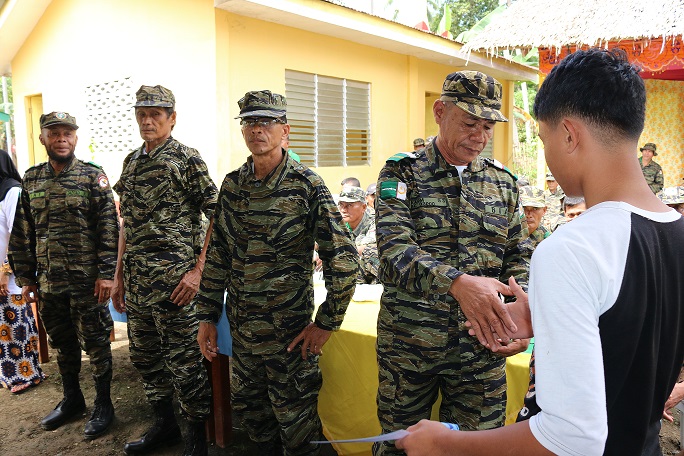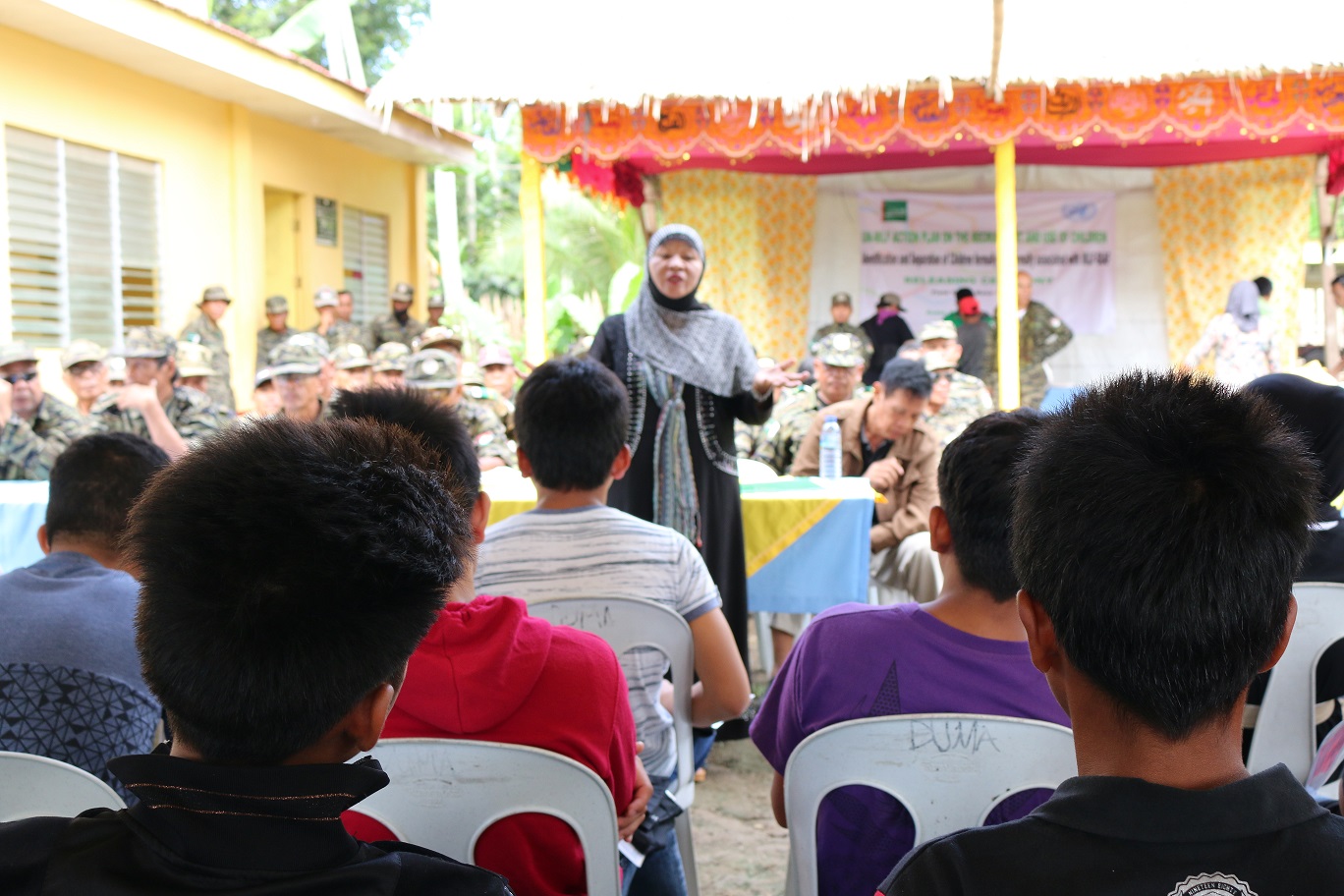
1,800 children formally disengaged from non-state armed group
"As children, you should be in school holding pens, not guns.” Wilma Madato, a training officer for the Bangsamoro Islamic Women Auxiliary Brigade (BIWAB) and member of the UN-MILF Action Plan Five-Person Panel, delivered a firm message to 36 children, along with their families and soldiers of the Field Guard base command of the Moro Islamic Liberation Front (MILF) in Maguindanao province. She was speaking at one of dozens of ceremonies that took place in February and March to formally disengage over 1,800 children from association with the MILF’s military arm, the Bangsamoro Islamic Armed Forces (BIAF) and its counterpart BIWAB.

Credit: OCHA/R. Higgins Pagalungan, Maguindanao (19 February 2017) - A disengagement certificate given to the children during the ceremony.
Disengagement efforts in the Philippines
The United Nations, led by UNICEF’s country office in the Philippines, supported this process, which began with the UN-MILF Action Plan to address the recruitment and use of children in armed conflict in Mindanao. The 2009 action plan, extended in 2013, commits the MILF to end the recruitment and use of children within their ranks. These ceremonies signify the culmination of years of initiatives to raise awareness and sensitize MILF members from the highest levels to front-line soldiers and families on the implications and impact on children who are recruited and used by their military arm.
At the field level in Mindanao and the national level in Manila, the UN Security Councilmandated country team for monitoring and reporting grave violations of children’s rights in situations of armed conflict has been central to the disengagement process. OCHA actively participates in this multi-lateral team chaired by UNICEF, which tracks incidents involving children and works with all parties involved to halt these grave violations. Additionally, OCHA advocates their protection through various media and means, including meetings with stakeholders and partners.
Lotta Sylwander, UNICEF Philippines Representative, says, “Children affected by armed conflict are among the most vulnerable in the world. Right here in the Philippines, children are affected by armed conflict in different ways. They can be recruited as soldiers and engaged in direct combat or simply be helpers at the camp. In any case, there are seriously harmful consequences threatening their life and well-being.”
Protection of children after disengagement
The action plan does not end with the disengagement of the children. MILF is obliged to monitor and screen its troops to ensure children are not associating or re-associating with its military camps. The released children can also avail of support and services from the Government and development partners to fully exercise their rights to health, education and protection.

Credit: UNICEF/ J. Marcella Pagalungan, Maguindanao (19 February 2017) - Wilma Madato reiterating message on prevention of re-association of children and accountability of parents and commanders.
“I ask you to pursue your studies because you are the future leaders of the Bangsamoro,” Madato said. “Education is key to knowing your rights and responsibilities, thereby making you good leaders someday." A former child soldier herself, Madato told her story to the audience, explaining the sacrifices she made. She asked the parents to support their children and ensure they stay in school, and the military commanders to uphold the BIAF Code of Conduct.
The Code of Conduct states all BIAF members must take feasible measures to ensure the protection of the rights and welfare of children affected by the armed conflict in Mindanao. It also forbids the recruitment of anyone under the age of 18.
At the disengagement ceremony, children and their parents also heard earnest messages from the front and base commanders and the base’s religious leader. Madato’s message was simple and to the point: “The certificate you received today represents that you are no longer associated with the soldiers. Please do not come back to the camps,” she said.
"I ask you to pursue your studies because you are the future leaders of the Bangsamoro. Education is key to knowing your rights and responsibilities, thereby making you good leaders someday." - Wilma Madato, Bangsamoro Islamic Women Auxiliary Group and a member of the 5-Person Panel on the UN-MILF Action Plan
Engaging disaster-affected communities in Bohol
The Community of Practice (CoP) on Community Engagement conducted a workshop on Rapid Information Communication Accountability Assessment (RICAA) in Bohol province in February. Thirty-five members from UN agencies, international non-governmental organizations, media groups, civil society organizations and faith-based groups reviewed how these assessment tools can be enhanced and incorporated into general needs assessments of a disaster-affected community.

OCHA introduced the RICAA tool in the weeks after Typhoon Haiyan that struck the Philippines in November 2013 as part of assessing information needs, preferred communication channels and identified accountability mechanisms of the affected communities. It was an entry point for the field-level working group on community engagement to conduct intensive community consultations, not just in the immediate response, but also in the weeks or months after the emergency. From 2014 to 2016, RICAA was also used by humanitarian agencies after the Zamboanga Crisis and the emergency responses to typhoons Hagupit, Koppu and Haima.
At the end of the workshop, CoP members used the RICAA tool to conduct a community consultation in four barangays of the municipality of Antequerra, one of the communities affected by a devastating earthquake that hit Bohol in 2013.
Mercedez Sala, one of the survivors they interviewed, said, “We will always be thankful to all the assistance we received from humanitarian organizations. But more than anything, we needed information on whether the situation was improving, so we could plan for the future. It is crucial for the government and other organizations to also recognize our plans for our family and community.” Her statement is a reminder that listening to what the people actually need is important.
Listening to the needs of an affected community
“In conducting assessments, humanitarian partners have different mandates,” says Giselle Alvarez of Center for Community Journalism and Development. “It can be tempting to assume the needs and concerns of affected populations. However, as we spend more time listening to what they say, it becomes clear that often we are missing opportunities to really help them. We really need to rethink how we engage affected populations, especially since they have the capacity to recognize not only their immediate needs but other evolving needs, as well,” she said.
Recognizing the evolving needs, coping mechanisms, local resiliency and adaptive capacity of any at-risk or vulnerable community is important as part of positioning the RICAA. It should fit into the capacities of the agencies and changing needs of the communities.
The tool can also be improved to better assess vulnerable and marginalized populations. Jeff Balistoy of HelpAge International-Coalition of Services of the Elderly (HelpAge- COSE) says integrating inclusive questions into the RICAA tool help. “We can capture critical information on preferred communication channels and accountability mechanisms available, including for vulnerable or more at-risk members of the community, like persons with disability, elderly, pregnant women, indigenous people, internally displaced communities and people living in geographically isolated and depressed areas,” he said.
Integrating with other reporting platforms
The workshop was also used for CoP members and stakeholders to integrate questions from the RICAA tool into common reporting platforms, such as OCHA’s KoBoToolbox and IOM’s community response map. They also experimented with the use of an unmanned aerial vehicle, ham radio, social media and emergency radios to collect and share information.
Current and upcoming technologies can be effectively incorporated to improve and complement community assessments, but care needs to be given to avoid employing technology for its own sake or resulting in something that is more complicated, rather than more efficient to use. It is necessary to utilize various platforms to ensure that the affected communities have access to the right information and agencies, and the humanitarian agencies have access to the assessment results.
“Definitely, it’s not a question on how complex it could be in terms of using a technology like drones to support any face-to-face consultation, Matthew Cua of SkyEye said. I think the most important thing is how ready are we to work with the affected communities? For instance, we need to explain to a barangay council how the technical maps, pre-crisis information and the RICAA questions all work together."
"It’s critical that common service platforms incorporate the RICAA tool to help capture the expressed needs of the affected communities. This could influence overall humanitarian programming. It’s a work in progress but we are getting there." - Jeff Balistoy of HelpAge/COSE
The Grand Bargain commitment in the Asia-Pacific
A set of commitments designated as The Grand Bargain was launched at the World Humanitarian Summit on May 2016. More than 30 humanitarian actors and donors pledged to ten work streams. Since the Grand Bargain was negotiated, there have been more signatories, with a total of 55 (22 donor and 28 humanitarian organizations).
While the commitments are a tall order, the critical issue of humanitarian financing has come to the forefront. The High-Level Panel on Humanitarian Financing Report to the Secretary-General, ‘Too important to fail: addressing the humanitarian financing gap’, where the Grand Bargain was first proposed, says that “never before has generosity been so insufficient. Over the recent years conflicts and natural disasters have led to fast-growing numbers of people in need and a funding gap for humanitarian action of an estimated US$15 billion.”
Asia-Pacific Dialogue on the Grand Bargain
On 28 February, an Asia-Pacific Regional Dialogue on the Grand Bargain was held in Bangkok,Thailand, to discuss progress made and challenges of the commitments outlined in the Grand Bargain. The outcome of the regional dialogue will be taken forward to the Regional Humanitarian Partnerships Forum for Asia and the Pacific in June 2017. The forum is held every two years and focuses on consolidating and promoting good practice in humanitarian action in Asia and the Pacific.
Among the concepts highlighted during the dialogue was localisation— increasing support and funding for local and national responders. According to the Global Humanitarian Assistance Report 2015, of all international humanitarian assistance, only 0.2 per cent went directly to local and national NGOs and 3.1 per cent to the governments of affected states.
Other opportunities discussed during the dialogue were the increasing the use of pooled funds or alternative funding mechanisms. Most countries in the Asia-Pacific region do not have country-based pooled funds. Only Afghanistan, Myanmar and Pakistan utilize this tool. Establishing pooled funds or local funding mechanisms could address the gap. Strengthening the capacity of national NGOs, which are in large number in the Asia-Pacific, is also a priority. While many national NGOs receive emergency funds or partnership agreements, there is a need for core funding and training programmes to build capacity, including for financial and administrative management. Tracking of local funding—how much a response is actually being implemented by national NGOs by a ‘localisation marker’—is also a challenge. Few countries in Asia have an ongoing humanitarian response or flash appeal in effect, so aid organisations and donors need to work closely towards more financial transparency.
Ongoing commitment
Local NGOs are welcome to sign the Grand Bargain by contacting the Grand Bargain Secretariat at hlpsecretariat-ocha@un.org. The Grand Bargain is not a binding agreement, but signatories take the commitments seriously and will report back annually on how they are achieving on the commitments.
| Ten Workstreams of the Grand Bargain | |
|---|---|
| 1. Greater transparency | 6. A participation revolution |
| 2. Support to local and national responders | 7. Multi-year planning and funding |
| 3. Cash-based programming | 8. Reduced earmarking contributions |
| 4. Reduced duplication | 9. Simplified reporting requirements |
| 5. Improved joint needs assessments | 10. Reduce humanitarian and development divide |
Local NGOs are welcome to sign the Grand Bargain by contacting the Grand Bargain Secretariat at hlpsecretariat-ocha@ un.org.